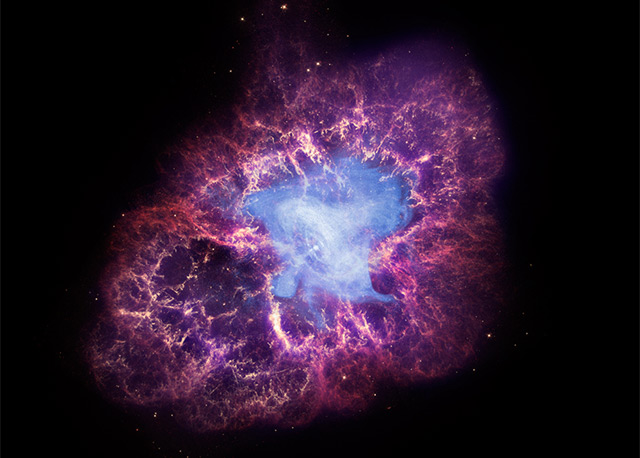A new study by scientists from the University of Southampton’s School of Mathematics explains how the spin of a pulsar slows down as the star gets older.

This composite image shows the Crab pulsar, a neutron star about 28–30 km across, at the center of the Crab Nebula. The new mathematical model, developed by Southampton scientists, can explain the observed behavior of young pulsars, such as the 958-year-old Crab pulsar (X-ray: NASA / CXC / SAO / F.Seward; optical: NASA / ESA / ASU / J.Hester & A.Loll; infrared: NASA / JPL-Caltech / Univ. Minn. / R.Gehrz)
Pulsars rotate at very stable speeds, but slow down as they emit radiation and lose their energy. Now, the scientists have found a way to predict how this ‘slowing’ process will develop in individual pulsars.
“A pulsar’s spin rate can be a very precise measurement of time which rivals the best atomic clocks, but in the end it will slow down,” said Dr Nils Andersson, co-author of the study reported in the journal Nature Physics (arXiv.org version).
“Until now, the nature of this slowing hasn’t been well understood, despite 40 years of research. However, our model will open the door on this process – extending our knowledge of how pulsars’ operate and helping to predict how they will behave in the future,” he said.
As a hot pulsar cools, its interior increasingly begins to turn superfluid – a state of matter which behaves like a fluid, but without a fluid’s friction or ‘viscosity’. It is this change of state which gradually affects the way that the star’s rotation slows down.
“The effect on the star’s rotation is like a figure skater extending their arms to slow their spin,” said lead author Dr Wynn Ho. “Our model can explain the observed behavior of young pulsars, such as the 958-year-old pulsar in the Crab nebula, which spins at 33 times a second.”
The findings have important implications for the next generation of radio telescopes being developed by large international collaborations, like the Square Kilometre Array and the Low Frequency Array. The discovery and monitoring of many more pulsars is one of the key scientific goals of these projects.
The new mathematical model, developed in the study, can be used in conjunction with these observations to predict how a pulsar’s rotation will change over time and enable scientists to peer inside these stars and explore their exotic composition.
“Our results provide a new method of linking the study of distant astronomical objects to laboratory work on Earth in both high-energy and low-temperature physics. It is an exciting example of interdisciplinary science,” Prof Andersson said.
_______
Bibliographic information: Wynn C. G. Ho & Nils Andersson. Rotational evolution of young pulsars due to superfluid decoupling. Nature Physics, published online 30 September 2012; doi: 10.1038/nphys2424







